The 50mm Lens: One of Best Classic Portrait Lengths
I’m fortunate enough to have been a pro shooter for many years now. I shoot a wide variety of subjects, but they all tend to fall into the categories of commercial portraits and fashion work. I’m always photographing people—no still lifes, product shots, or architecture. To say that I always photograph people as a portrait and fashion photographer may seem like an obvious statement, but it has a crucial impact for me and the lenses in which I choose to invest.
In addition to being a professional editorial and fashion photographer, I’m also heavily involved in training emerging photographers in the industry. The one question I get asked the most is: “Which lens should I buy to attain the best classic portraits?”
This is a very poignant question and one that we have all faced at least once in our photographic journey. To answer this question properly though, you have to bear in mind a few key factors, such as what you plan to photograph and whether you are allowed any creative freedom in capturing it.
If you’re going to be photographing products and architecture, then you need to bear in mind that 99% of the time you’ll have to document these things without any distortion and with very limited creative freedom. If you take a picture of a building with a 50mm lens from the ground, the distortion lines created by that lens can give the impression of it falling over. The same theory applies to smaller still life shots. Certain focal lengths of lenses are not suited to properly represent the straight lines we see in architecture and packaging. Your client is not going to be overly happy when you show them their building appearing to fall over or their packaging appearing bent and warped.
If, on the other hand, you are going to be photographing people, there are no straight lines in sight and you can afford to use the lens distortions to your advantage.
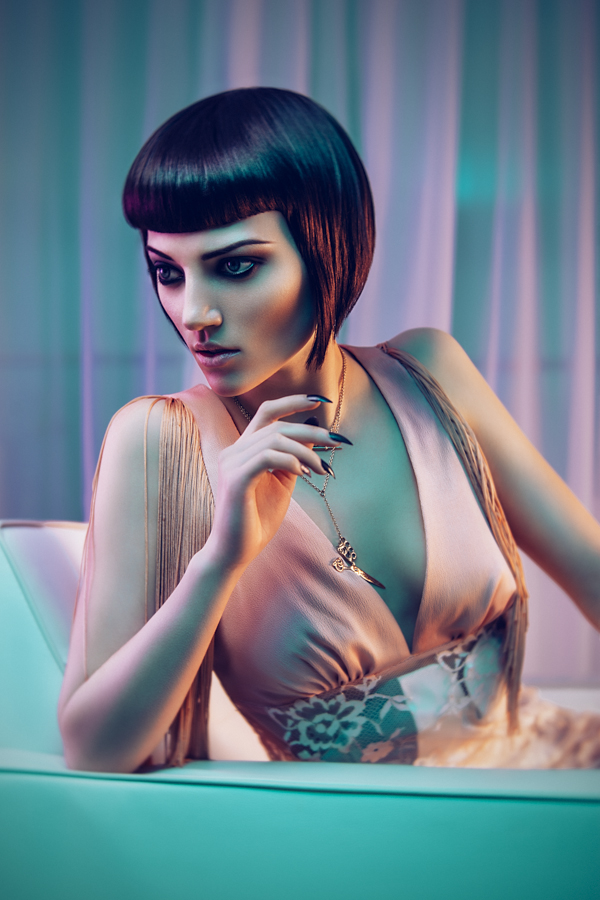
Photographer: Jake Hicks; Model: Jordan Ebbitt
This shot was taken with the Lensbaby Velvet 56 lens. Even with the model’s hand closer to lens than her face, the distortion is minimal and certainly not distracting.
If you’ve made it this far, I’m sure you’ve probably realized this isn’t going to be a scientific article with distortion charts and algebraic formulas. This is simply my advice and opinion based on many years of experience and client perceptions of the work that I produce for them. If I’ve taken a portrait shot with my 50mm lens and I’ve made my subject appear taller—and thus slimmer—then they have yet to complain about such lens distortion! The point I’m making here is that, as photographers, we’re all in a creative field. We have creative freedom to create what we perceive to look good, not necessarily what looks “right.”
Understanding the Key Differences Between 50mm and 85mm Lenses
Let’s back it up here a second. What actually is “right” when taking a portrait or fashion shot? What is deemed “right” by photographers is usually dictated by what the human eyes see. If you attach an 85mm lens to a full frame DSLR, hold it in portrait orientation, and then open both eyes and look through the viewfinder, you should see that both of the images from each eye line up, almost like you aren’t looking through a lens at all. Do the same with a 50mm lens and you’ll soon find that you can no longer merge the two images together. This happens because the 50mm lens is distorting its field of view. To photograph your subject in anything but 85mm then would cause some sort of distortion. This is the theory behind the slightly dated notion that 85mm-105mm are the classic sweet spot focal lengths to eliminate any accidental distortion.

Photographer: Jake Hicks; Model: Zuki Jai
This image was shot with an 85mm lens to maximize the impact of the look from the model. The 85mm lens has compressed the image so that nothing appears closer or further away and all of the attention is brought to the model’s eyes.
As I just stated above, an 85mm lens is going to give you a more accurate representation of what’s in front of you. This lens will compress the shot so that things that are slightly closer to the camera appear to be on the same plane as things that are slightly further away. This will not only create some really nice shallow depth of field effects, but it also can be a little easier in general for beginner photographers to use. An 85mm lens won’t distort the subject in any way and will only compress your image, so whichever angle you decide to shoot your subject from you’re going to get pleasing results. For example, if somebody has a large nose and you photograph them with an 85mm lens, this won’t distort the nose but will rather give the impression of it being closer to the face and thus smaller. If you’d taken the same shot with a 50mm lens, you would certainly need to be a lot more careful about the position you photograph your subject from.
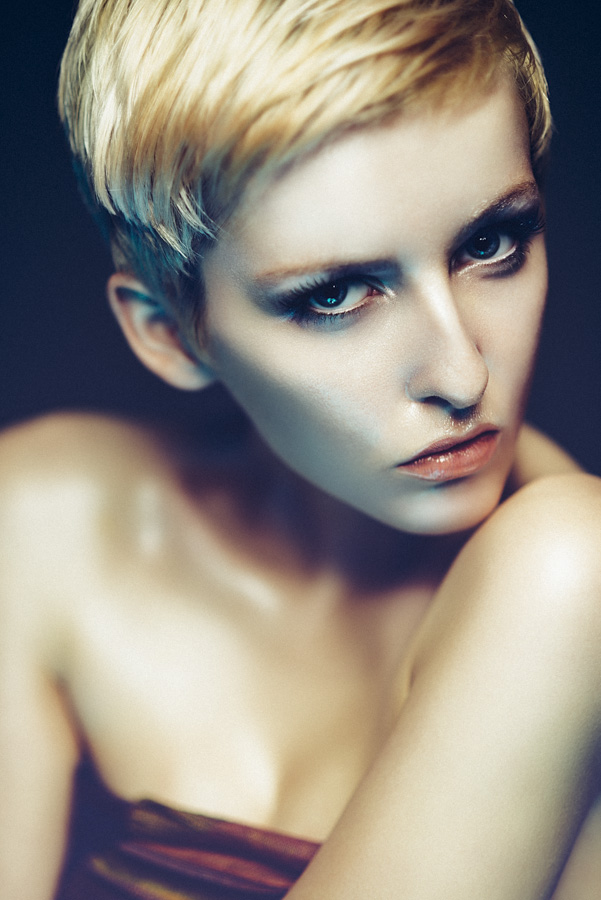
Photographer: Jake Hicks; Model: Amber Tutton; Makeup Artist: ChandniMUA
85mm lenses are great for tighter crop shots like this one. Here you can see that I’m very close to the model. Had I been using a 50mm lens, then I probably would have distorted her face and shoulder too much, which may have been distracting to the viewer.
Selecting a Classic Portrait Lens: 50mm or 85mm?
Perfect. So if an 85mm lens won’t distort my image and I can pop it on my camera and shoot away without worrying about making people look ugly, then why on earth would I ever want a 50mm lens? The reason you may want one is so that you can enhance what’s in front of your camera, using experience and a little knowledge. The 50mm lens will definitely distort your subject. This will become more pronounced the closer you are to your subject, but you can use this distortion to your advantage with the right technique. If you get down a little lower than your standing subject (for example, you can start shooting up at them), you can make them look a little taller and thus a little slimmer. This won’t work all the time. It does depend on the body shape, but with a little experimentation you can usually find the right angle.
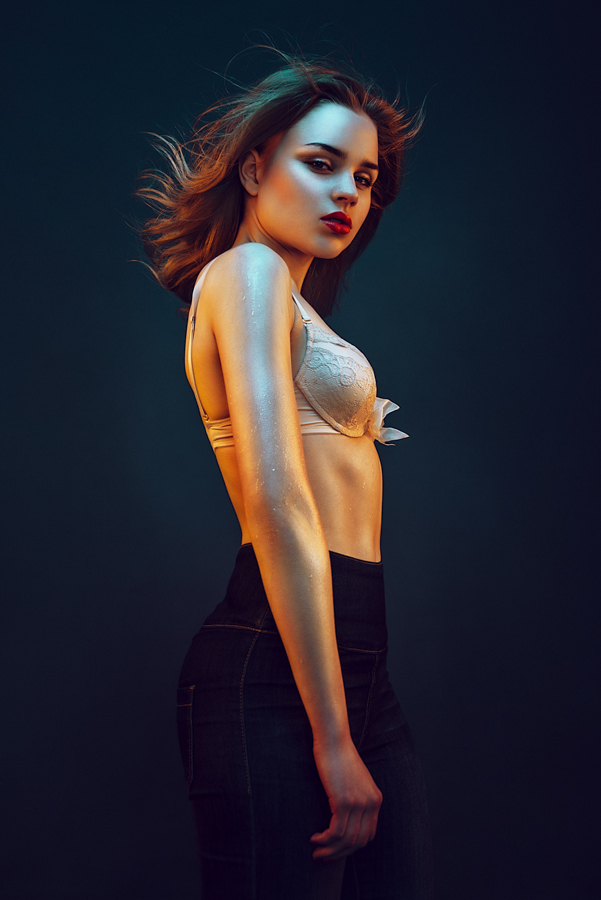
Photographer: Jake Hicks; Model: Heidi Elizabeth Gold
This image was taken of a singer who was was much shorter than the typical 5’10″ height of a professional model. I was sitting on the floor looking up at her with my 50mm lens and from this angle I was able to utilize the lens distortion to make her appear taller and more dominant in the image.
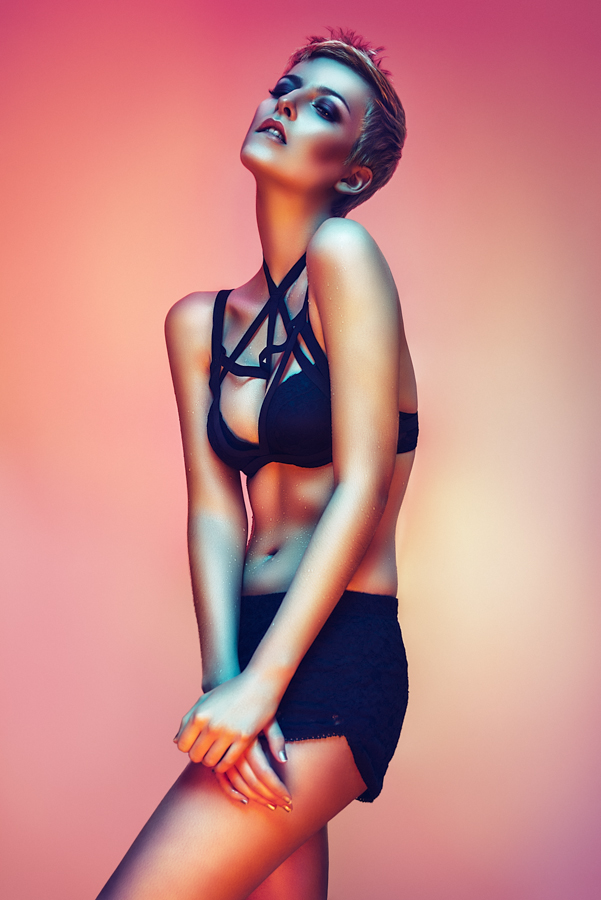
Photographer: Jake Hicks; Model: Amber Tutton; Makeup Artist: ChandniMUA
Again, I sat on the floor shooting up at my model with a 50mm lens to take this shot. I personally like the extra depth a 50mm lens gives you in a shot like this. A longer lens may well have compressed the image, but I like how the model’s shoulders have been given extra shape through the lens distortion.
There are also times when you’ll be shooting in an interesting environment and you’d like to show more of the subject’s surroundings. This will be very tricky with an 85mm lens as it is more zoomed in, eliminating any room for your location to be displayed as well. The 50mm lens, on the other hand, with the proper usage, will have just enough distortion to show a lot of your surroundings but without distorting your subject negatively.
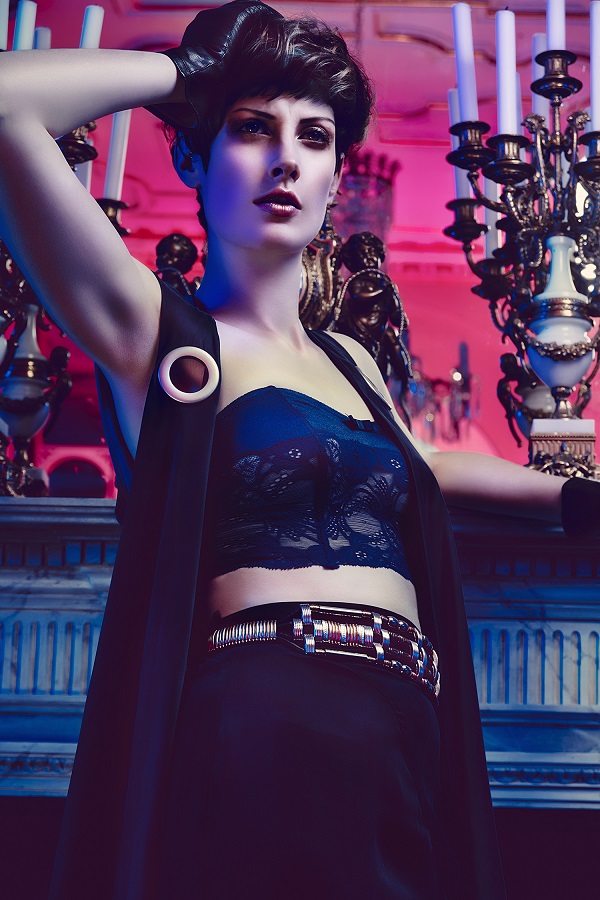
Photographer: Jake Hicks; Model: Kimi Frances
This is another 85mm shot but this time taken on location. The shot is a tighter crop and as such the 85mm lens compresses the image, leaving little room for distortion but also eliminating the majority of the model’s surroundings.
I personally use 50mm lenses all the time, whether it be in the studio or on location. I find them by far and away the more versatile choice. The most recent lens purchase I made was the new Lensbaby Velvet 56, classic portrait lens. Not only did I want the lens’ signature edge diffusion, but I also wanted a lens that could properly represent my model and the location she was in for an upcoming editorial. It was a fashion shoot in a penthouse apartment, so I knew that not only would the space be tight but that I also wanted to show elements of the location in the shot with the model. With the available space and look I was after in mind, this shoot would just not have been possible with an 85mm lens.
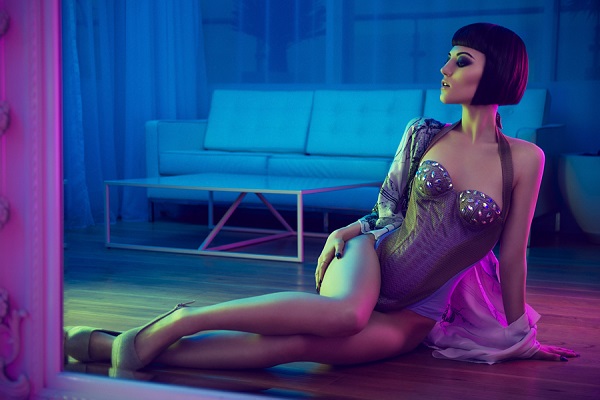
Photographer: Jake Hicks; Model: Jordan Ebbitt
I was very pushed for space in this shot as I am actually photographing the model’s reflection in a mirror. It was only possible to get the whole scene in with the wider focal length of the Lensbaby Velvet 56.
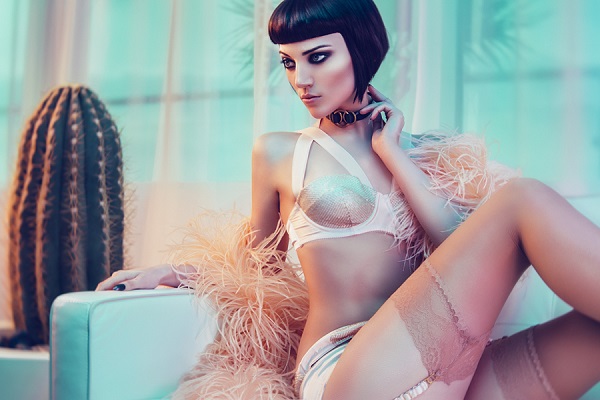
Photographer: Jake Hicks; Model: Jordan Ebbitt
For this shot I used the Lensbaby Velvet 56 again, and I’m really pushing how far I can get away with the lens distortion a 50mm gives you. I really wanted a wider shot like this so I could get more of the model’s environment in the frame. I am at just the right distance from the model to avoid distorting her legs any more. Had I been any closer, her legs would appear abnormally large in relation to the rest of her body.
Bottom Line
If I could only take one lens to a portrait shoot, without hesitation it would be a 50mm lens. Yes, the 50mm does distort the subject whereas the 85mm lens doesn’t. However, with the proper skill and experience you can easily make this distortion work for you and not against you. Remember that we are the creatives. It’s up to us to make creative decisions on how our images look “best,” not “right.”
—
Jake Hicks is an Editorial and Fashion photographer and an educator based in the UK – Jake is currently running a Gelled Lighting workshop that goes over the lighting techniques he uses so if you’d like to find out more go check out the ‘Training‘ section of his site.




September 29, 2018 at 5:49 pm, Amanda Hitchen said:
This is so helpful – thank you! I’ve been shooting for years and have always struggled with trying to understand what a 50mm does and how to use it properly. Thanks again!
September 24, 2018 at 1:54 pm, Andy Craddock said:
I know the whole ‘art is subjective’ but this is pure editorial. Not art at all. The lighting is flawless but I prefer a more natural light. The composure is mostly on point but I’m old school and hate hands cut off at the wrist and middle forearm. You’re not shooting amputees these girls have both hands I assume? But. The post processing leaves the models looking plastic and without emotion. Skin by design is meant to be textured. Models have natural flaws and these flaws should remain unless the MUA chooses to mask them. Like others have said, this could have been created on any 3D modelling programme. In fact, the top games companies, probably the best in the world at 3D animation and modelling actually make skin textured. To make their characters look real.
No doubt there is skill here but you can push things too far.
For my 10 cents, I personally prefer the natural look of the 85mm and shoot with a 85mm f/1.2L on a Full Frame. I like the fact it makes me move to compose rather than zoom in/zoom out and the 1.2 obviously creates wonderful bokeh when wide open. I’ve shot in very tight spaces and never had a problem with the longer lens. If you have to get right in the models grill to get the shot then you do, sometimes it creates an expression you didn’t expect and that shows the personality of the model. Personality is the difference between editorial/illustration and ‘art’.
Feel free to flame me if you disagree but this is only personal preference and opinion. As was the original article.
September 23, 2018 at 1:22 pm, Silverstream said:
I have started to use my new Sigma 105mm f1.4 for all my portraits. Its an amazing lens. But I do most of my work outdoors so I can get as far back as I need.
September 22, 2018 at 3:06 pm, Ashley Sowter said:
Great read and information Jake. Thanks for sharing your experience, knowledge and personal opinion as well as your images for reference.
September 22, 2018 at 10:08 am, Bernardo said:
This looks like 3D pictures created on a PC without a camera for an PC game.
Not my kind of photography – if it is at all…
January 12, 2018 at 11:35 am, Leslie Savege said:
Like most of these Mayhem articles, it is a waist of time reading. The author seems to be more interested in showing off his photos than giving examples of what he is talking about.
January 12, 2018 at 8:28 am, uaio said:
Truly amazing photography doing!
January 10, 2018 at 11:04 pm, Duc Duc Duc said:
I am surprised how many comments are filled with hatred towards the style of the photographer. Newsflash: This is art, it’s all a matter of taste. If you don’t have anything nice to say, then don’t say anything.
January 13, 2018 at 2:58 am, Bernardo said:
ART is in the eye of the beholder my dear friend!
If you cannot tolerate other opinions then be less aggressive – good for your health too.
The photos of the author are very well framed and perfectly exposed – no doubt – though not perfect.
The last one i.e. cuts of the leg and a significant part of the head, the heavy post processing does not compensate for this flaw – in my opinion.
The post processing though is delivering a kind of Manga Style cartoon result.
There is no skin no wrinkle no pore anymore visible, colors are artificial.
To me most of the models don’t look human anymore to me – that is in no way as the headline states “a classical portrait”.
PORTRAITS [my personal opinion] should allow a glimpse into the person and at best their soul.
What we see here is pure advertisement photography and that is without any jealousy because it is nothing I strive for nor would it be difficult to repeat.
There are commercial programs that create that look with a simple click.
September 22, 2018 at 10:12 am, Bernardo said:
LOL – there is no hatred – at least from my side.
ART – to my personal definition is at least to create something new and creative.
Such pics are around plenty on the web – I cannot find anything amazing about them.
It is a very good handicraft though on the edit – I agree on this – IF – and that I cannot answer a quick and handy program did the job.
January 10, 2018 at 3:53 pm, Dportrait Melbourne said:
This article distorts the truth. 50mm lenses don’t distort. Nor do 85mm lenses.
A 50mm is supposed to give a “natural” perspective to a shot (with a full size 35mm sensor / film). Longer lenses like the 85mm compress the perspective so are generally considered more flattering, it makes the nose seem smaller for example. This is especially noticeable for close up shots of faces. Which is why most wedding photographers shoot with a 70-200 as their main portrait lens.
The writer seems to mostly shoot wide scenes in small spaces, so I can see how a 50 suits his style. However this is not classic portraiture.
Lensbaby lenses may distort, but that is by design.
January 10, 2018 at 2:16 pm, Jim Miller said:
I know these horrid filters are popular with the kids these days, but I personally don’t like the orange and blue skin or deadened eyes of these ‘photos’. 50mm IS a great portrait lens, but only in the hands of a photographer – not a comic book illustrator.
January 16, 2018 at 6:41 am, Colby Files said:
Wow
September 22, 2018 at 8:26 am, Nathan Zahorchak said:
They’re called gels, not filters. They’re light modifiers, not Photoshop filters.
September 24, 2018 at 7:17 am, Brett Middaugh said:
HA! Never go full, “kids these days”, at one point…you were those kids.
September 14, 2017 at 1:59 am, aldo bianchi said:
“Yes, the 50mm does distort the subject whereas the 85mm lens doesn’t”
No, actually a 50mm does not distort anything, it is only a change of perspective: if you shot at the same distance with an 85mm and a 50mm and then crop the second image you’ll have the same result. It’s important to speak about perspective, not distortion, because being aware of this will be useful also in taking care of image background.
September 14, 2017 at 4:14 pm, Maurice Benfredj said:
We are comparing apples with oranges here. if you shoot with a 50 mm lens from the same distance as with an 85 mm “portrait lens”, you’ll end up with a lot of area you need to crop to get to a similar sense of presence. In other words, using the same camera would give you far fewer DPI for the same frame with the subject being of similar size. As you say, different perspective, but also different print quality. That limits your ability for further cropping and other post-production that is common these days. The two focal lengths will give you completely different results, each with its own dis/advantages. On balance, I still think that the lesser invasion of personal space (which inhibits the model) combined with the flatter image gives the 85 mm lens an advantage,
September 14, 2017 at 1:36 am, Chris Jones said:
Great article, very informative and well explained. The two focal lengths are so close together but have such differences. Thanks for dissecting it. One thing though – lay off the skin smoothing dude!!! after taking the time to get the lighting and shots right you’ve then totally undone all that hard work by completely obliterating any shape and form of your models with heavy-handed retouching.
September 13, 2017 at 9:12 pm, gia_miamibeach said:
if you call 50mm lens classic, why do the images in this article look as animated graphics. For that matter, you just need a computer. This is no longer a photograph.
September 13, 2017 at 12:48 pm, Robert L. Gaskin said:
Love the lighting
September 13, 2017 at 12:36 pm, twobe1 said:
Thanks very much for this.
January 05, 2017 at 3:18 pm, Peter Moeller said:
No focal length distorts. It is the working distance that creates distortion. The shorter the camera to subject distance, the more distortion. And shorter focal lengths like 50mm, when used to frame a headshot or upper body portrait will often result in distortion, because the distance to achieve this frame is short. Also, can only assume the article talks about full frame sensor size? Because on a crop sensor, 50mm behaves like 75mm.
On full frame, 50mm are good for full length portraits, couples, small groups. For headshots or upper body portraits framed with a 50mm on full frame, there will be distortion… Although camera placement and posing can be used to overcome distracting distortion in many cases. The article mentions this.
For beginners, working on full frame, with focal length longer than 50mm, like 80 or longer, will avoid distortion.
50mm is “general purpose” and amazing portraits certainly can and have been taken with this focal length. Why some insist 50mm “is the best portrait focal length” I personally cannot understand.
Maybe for their personal style, this is correct. As a general statement, I will disable…
Saying that, a 24-70mm is the lens I use for 80 percent of my people photography, and 50mm is right in that range.
September 14, 2017 at 1:52 am, aldo bianchi said:
or, maybe better, it is just a change in the perspective we must not speak about distortion…
February 10, 2016 at 3:45 am, jerry said:
This might be a bit off-topic, as it does not address the lenses, but rather the photo content. My questions is how do you get that surreal smooth skin texture? I see this more and more, it is really inters testing.
November 05, 2015 at 10:55 am, Dweezle.Di said:
Interesting, I am curious are we to assume this is shooting with a 35 mm? Digital or analogue? I was told to multiply the focal length of a standard 35mm lens by 1.6 and that will make a 35mm 50mm Lens equivalent to a 80mm.
January 21, 2016 at 11:03 am, Paul B. Karas Sr. said:
If you are using a camera with an APS sensor (lie the 7D I use) then the 1.6X correction is correct. But if you are shooting a full frame camera, then the 1.6 doesn’t apply. Whether you shoot film or digital doesn’t matter.
January 21, 2016 at 11:52 am, Dweezle.Di said:
I have shot exclusively film since the 1970’s. I loved Panatomic X and in later years came to love Tech Pan. I now got a deal on a used EOS 550D to play with. it lasted 8 months before it needed major repairs. I have returned to my EOS 1n, as well as my old faithful Rebel G as well as my Toyo 4×5 with a 360mm Schneider lens. I shoot exclusively with a Canon 20mm & 100mm Macro I was originally told the 80mm was the ideal Portrait lens. I prefer the 100 Macro as I can get close without invading the personal space of talent. I have not owned a 50mm lens since my first F-1 came with it, (1975?). I always stuck with fixed format glass but I have learned the APS limitations since getting my 550D. I am in Thailand now, and it is even harder to find quality film here especially in 4×5 format. I wish the Canon repair facility will finish the repairs soon. Thanks for the info.
October 21, 2015 at 4:56 pm, ksporry said:
Nice article, very interesting! I’m glad my eyes are not considered weird, because I was told that traditionally 50mm is what the eye sees and I always thought 85 gave a better view of what my eye sees. Glad to see that confirmed.
I actually never considered 50mm for portraiture. Usually I use 85-135 (depending on my mood), or 35 for environmental portraits, or for distortions effects giving the portraits a special look.
I’ll try that 50mm some time.
October 15, 2015 at 7:23 am, Chris Walter said:
I tend to use my Nikkor 85mm 1.4 but occasionally pull out a manual 1980’s 50mm 1.4 which wide open has a hint of softness (probably needs a clean).
Also used to use lots of gels for various colour effects but have settled on a basic style which the models tend to like, at least their agency does.
Also have the Leica 50mm f2 APO which is phenominally sharp and being manually focussed can be amazing as it has a different look to the NiCans.
January 21, 2016 at 11:59 am, Dweezle.Di said:
Leica has phenomenal glass. when I was in the Army I was issued a Leica Rangefinder kit with an assortment of lenses, I am not sure now, but I believe a 35mm, 50mm, & 125mm. the sharpness was even better than my F-1 with Canon FD 50mm 1.4.
October 14, 2015 at 5:38 pm, bebekashmir said:
It’s actually hard to spend too much time reading this because the photo examples are just so damn good! I haven’t ever really felt the desire to get any expensive comprehensive courses but I’m actually thinking about yours now. Your light and color management is incredible.
October 14, 2015 at 5:25 pm, tekwrite said:
What if you do not have a full frame camera? I have a Canon T2i and both the 50 mm 1.8 and the 85mm 1.8.
January 21, 2016 at 11:07 am, Paul B. Karas Sr. said:
The canon T2i does have an APS-C sensor, which means that you must multiply your focal length by 1.6X – your 50mm is more like an 80mm on a full frame camera. You’ll need to go down to a 30mm lens (48mm equivalent) to approach the 50mm focal length on a full frame camera.
September 13, 2017 at 2:07 pm, Chris Mansfield said:
Optically the focal length is irrelevant to your sensor size. A 50mm from distance “D” will be identical to that on a crop sensor, its just that the image will be cropped by about 30%. So to get the same coverage either move back (increase distance) or get a shorter lens. However, doing either will differ from the 50mm “perspective”. This is the very reason they are still measured as a 50mm lens. Focal length is about perspective NOT crop, and when photographing portraiture keeping the nose in perspective to the rest of the face is a bit of a consideration
October 14, 2015 at 4:01 pm, Hugh said:
Not sure I agree . . . about the ’50’. Your work is flawless and your Mastery of lighting is obvious [and I think I am qualified to give an opinion as I have over 50 years professional experience in photography plus I was taught Portraiture by a PPA Master Photographer]. Personally, I do have a Nikon 50mm f1.4, but rarely use it. My “Do-All” model lens is a
28-105mm f2.8 thruout and I don’t even check where it is set when shooting as far as focal length goes. I ‘zoom’/’unzoom’ until I have the right [for me] perspective & framing that I like and then push the little button that goes ‘click’- aperture is always preset for the light. Obviously, if I’m shooting a tight Headshot, the “MM” will be higher [usually around 75-85mm on a ‘cropped’ sensor]. A full length shot will be wider- maybe 45-60mm. Point is, by NOT using “Primes”, I don’t have to worry about moving up or back, distracting the model and/or confusing my aged brain. My #1 concern is establishing a ‘distance’ from the model that is close enough for communication without yelling, but NOT so close as to make her feel uncomfortable [necessary as I have done a lot of Nudes]. Every model is different and her ‘comfort zone’ is slightly different. The wide zoom [28-105] facilitates a great deal of flexibility and the 2.8 aperture allows me to crop/frame/compose thru the viewfinder. Also, I rarely use a tripod as my shutter pretty much stays at 1/250th.
October 15, 2015 at 1:12 pm, Eric Dye said:
28-105 f/2.8 throughout? I don’t believe I ever heard of a lens existing. I’ve heard of 28-105 f/2.8-f/4 though
October 15, 2015 at 4:42 pm, Hugh said:
Check out the Tamron SP 28-105mm f2.8 THROUGHOUT. I’ve had that lens for around 10 years, so you can see how much ahead of Canon & Nikon Tamron is. I also have the 70-210mm f2,8 THROUGHOUT . . . also Tamron SP. The one Tamron SP that is NOT throughout is my 17-35mm f2.8-4. I also had a Tamron SP 20-40mm f2.7-4, but sold it when I got the 17-35.
January 05, 2017 at 12:44 pm, Bmart27 said:
Is the Tamron SP 28-105 f2.8 for full frame cameras or crop sensored cameras or both?
October 15, 2015 at 4:44 pm, Hugh said:
Eric,
It’s a Tamron SP.
Hugh
Subject: Re: Comment on The 50mm Lens: One of Best Classic Portrait Lengths
October 16, 2015 at 7:26 am, Jim Wolff said:
I also have a Tamron AF-S 28-75mm, F2.8 throughout, and it is my favorite lens, but when it comes to doing portraits or similar work indoors, I prefer my F1.4 speed for low light shots. I wish I could find a good zoom, 28-105mm, AF-S, with a F1.4, but if I did, I’m sure I could not afford it.
October 14, 2015 at 2:45 pm, Ruud van Gaal said:
Nicely detailed article there! And great pictures too, peeks my interest again on color gels.
October 14, 2015 at 2:15 pm, Shawn said:
Thanks for the detailed explanation! Your work is incredible.
October 14, 2015 at 1:12 pm, Chevelle Nova said:
Your photos are incredibly well put together. All the models, the lighting and angles created with the lighting. The art in which it was shot. I would love to see some more of your work. It is inspiring me to create!
October 09, 2015 at 10:32 pm, HarryL said:
Thank you for this detail review. Definitely for a long time my thoughts & believes for the 50mm lens YES, isn’t for everyone its a great challenge I have used in food photography , Architecture , concerts, fashion, etc. It has been an amazing companion I don’t have more to say You covered. 2years ago got the 1.2 = pure love.
Thank you Again!!
October 14, 2015 at 1:38 pm, Jim Wolff said:
I totally agree. I like my 50mm, F1.4. Great for so many things I shoot. Of course, I’d love to have a F1.2, but probably not this payday… 🙂
October 15, 2015 at 9:52 pm, HarryL said:
1.2 Its pretty amazing dreamy performer Earlier last year I shoot nature in Botanic Garden. Include butterfly’s in captive also some dragon fly’s. As it is they look coming out from a dream world. If those effects was in Photoshop
would have been obvious. It worth to rent 🙂